Golf – Dynamics of speed
Good players make hitting the ball a long way look easy because they work with the laws of physics and understand the importance of inspiring a motion that features ‘lag’ and a whiplash effect that accelerates the clubhead through the ball. Inherent in this action is a flexibility and athleticism that emanates directly from the set-up.
‘Soft’, supple arms add to athleticism
If I handed you a tennis ball and asked you to throw it as far as you could my bet is that you would hold the ball fairly lightly in your hand so as to keep your throwing arm relaxed – after all, you want that arm to generate the maximum speed possible as you wind and unwind your body in the act of making the throw.
Golf – Dynamics of speed
Exactly the same principle holds true in golf. With a driver in your hands, you want to hold the club in such a way that you leave your arms and shoulders as relaxed and flexible as you can, so that in the process of winding and unwinding your body to create a golf swing you reap the benefit of the ‘lag’ and the recoil that accelerates the golf club through the ball at impact. Any sign of tension and that fluidity of motion, that natural physical dynamic, is going to be diminished.

Golf – Dynamics of speed
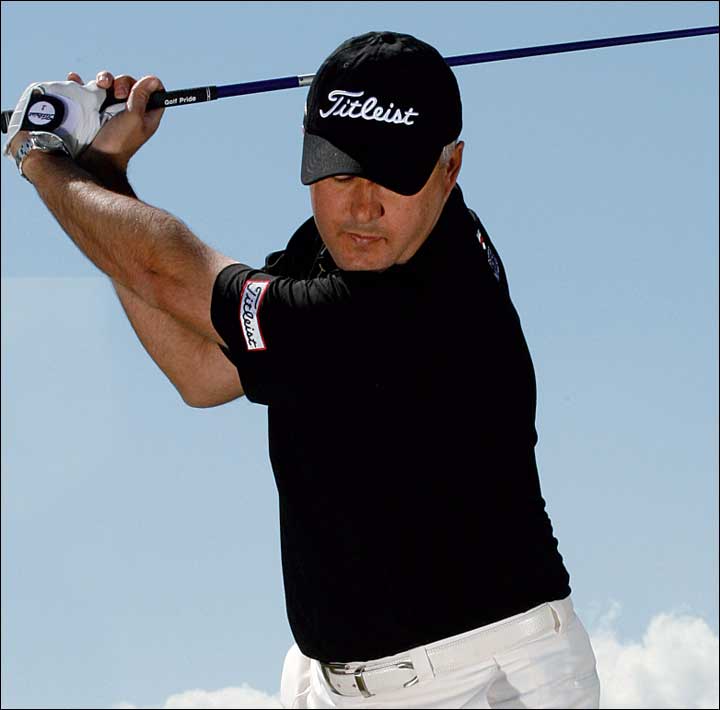
Golf – Dynamics of speed
So one of the most important lessons to be aware of in the long game revolves around the quality of the set-up position – and specifically the way you hold the club and prime your hands, arms and body to move as efficiently as possible in the swing itself. Having assumed a good posture, turn your attention to your grip pressure and the effect this has on the muscles in your wrists and forearms.
Golf – Dynamics of speed
Keep your pressure sensitive to the demands of the swing. Squeeze too tight and you inadvertently grid-lock not only the muscles in your arms but also the neck and the shoulders, destroying all hope of creating ‘flash speed’ through the ball with an athletic movement.
A good waggle can help you. Hingeing the wrists to the right while maintaining the position of the arms not only keeps the hands and forearms relaxed but it primes the wrist action you are then looking to achieve in the backswing. Challenge yourself to crank the wrists into this fully ‘loaded’ position by the time the left arm reaches horizontal – that will give you a wonderful sensation of building speed in the clubhead which works as a momentum builder on the way to a full shoulder turn and backswing coil.
Left knee, hip & shoulder lead the way back to the ball
Creating and maintaining resistance in the lower body is vital in the process of winding your torso and ‘loading’ your backswing with energy. The knees play a significant role in stabilising this rotation and maintaining the ‘level’s of a good swing. One way to experience this is to rehearse making your backswing with your right heel raised half an inch off the ground. In a good posture, this has the effect of really engaging the right knee and thigh as you shift your weight across and on to the right side while simultaneously coiling your upper body.
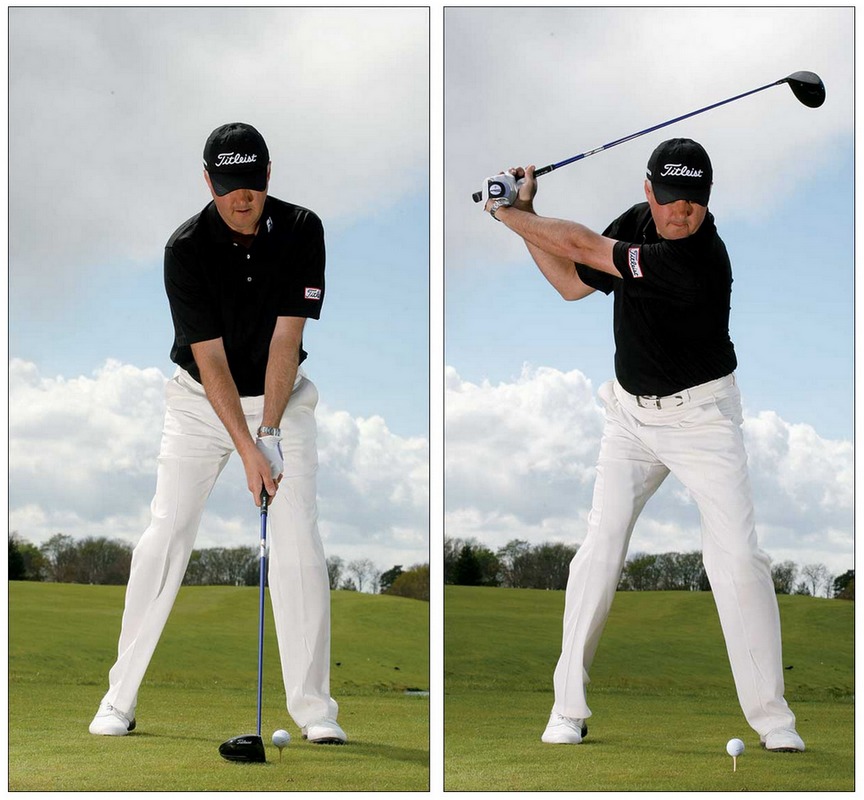
Golf – Dynamics of speed

Golf – Dynamics of speed
Keeping that right heel raised guards against over-turning the hips and rewards you with a highly efficient coil – this three-quarter backswing position, with the wrists fully hinged, is more than capable of producing a burst of acceleration into the ball for impact.
Harnessing the full speed potential of a good body action is all about the quality of your transition from the fully loaded position as you shift through the gears and unwind into the downswing. You will have heard it said before, but the feeling here is that you are effectively moving in two directions at once; as the momentum of the clubhead pulls you into the final moments of the backswing, so your lower body is returning towards the target – the recoil.
The position opposite is posed to illustrate the key feelings you want to be experiencing in this all-important move: the left knee and left hip re-rotate to create this ‘squat’ look as momentum is reversed. The natural consequence of this is a shallowing of the right arm and shoulder in readiness for the acceleration of the clubhead into the ball. Note that the angle in the right wrist is maintained (even increased) through this change of direction. This is where ‘soft’ hands and forearms really counts – retaining that angle in the wrists enables you to then multiply the speed with a final burst of speed as the clubhead is finally released through the ball.
Left knee, hip & shoulder lead the way back to the ball
One of the most significant areas that I want to highlight in this feature is the ‘separation’ of the left shoulder away from the chin at the start of the downswing. I’ve always been a huge fan of Nick Faldo’s swing and his teaching and this has always been an area that he maintains as being critical in the correct sequence from the top of the backswing.
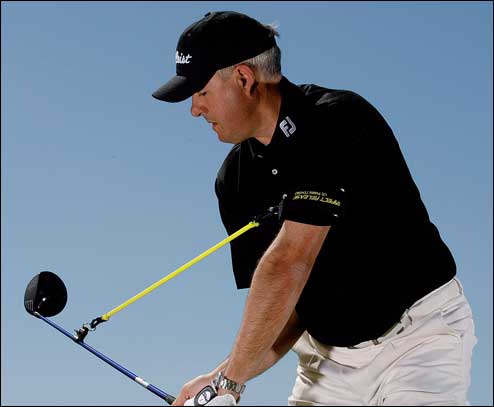
Golf – Dynamics of speed
The separation of the left shoulder away from the chin at the start of the downswing is one of the critical moves in a solid and dynamic golf swing. As the left knee and left shoulder pull away together, so the unit of the arms and the club drops to the inside. The elasticated cord that I am using is called a Power Release, and is one of several training products available through a new website www.sportstechlab.com
With the benefit of the elasticated flexi-cord, rehearsing this move from the top makes for a wonderful feeling of co-ordinated motion as the upper body responds to the transition in the knees and hips and begins its journey back in the direction of the target. The feeling here is that I am pulling the left shoulder away from the chin, working the right elbow in nicely to my stomach while retaining the angle in the wrists for that clubhead ‘lag’ that promises such speed through the ball.
When you are on the range hitting balls, stop every couple of shots and rehearse this move from the top – close your eyes and do it in slow motion, allowing the sensations to soak in.
A key point to make here is that the two shoulders are not fixed as if joined together on a single axle – they are free agents and can move independently of one another. When you analyse the movement what we are actually seeing here is a shoulder move that reflects the way in which the knees are working to this ‘squat’ position – just as the left knee is pulling away from a ‘posted’ right, so your left shoulder momentarily pulls away from its opposite number. This is the dynamic that gets you into a perfect hitting position. Once you have negotiated this move, the right side is able to fire and pour on the power as it rotates all the way through the shot, accelerating the arms, hands and clubhead.
Just remember that a good body action alone is worth nothing without the fluidity of the arms and the body that enables you to translate energy into speed. A good grip and sensitive grip pressure provides the conduit that channels and multiplies speed down the clubshaft and into the clubhead – so keep those hands, arms and shoulders supple.
Feel the power whip… and speed your way to a balanced finish
Ben Hogan famously wrote that when it came to the moment of truth in the golf swing – the area through impact – he wished he had two right hands. The legendary ball striker was referring to the wonderful sensation you get when you use your body correctly, rotating and clearing out of the way so the final burst of speed can be applied to the back of the ball. Two right hands, twice the power!
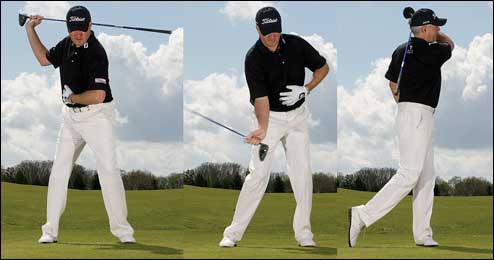
Golf – Dynamics of speed
Engage your ‘core’ muscles as you wind up for a powerful swish
Hold the ‘lag’ in your right wrist until the last possible moment…
…and unwind all the way through to finish facing your target
Developing the ability to whip the right hand through the impact area is something that is often overlooked – and yet it’s the most natural of actions for the right-handed player (left if you play left-handed). Turning your driver around and swishing the grip-end makes for a simple exercise that can help you to identify with the feeling of the ‘power whip’, the challenge being to create the loudest swish possible at the lowest point in the swing arc.
Reminding yourself of this feeling on a regular basis can help you achieve a better action in the golf swing, and I would recommend taking it all the way to a full finish, holding your balance for a couple of seconds. Pay attention also to the rehingeing of the club that occurs halfway into the follow-through.
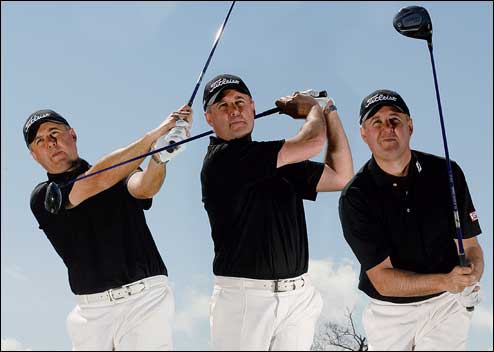
Golf – Dynamics of speed
This re-hinge is a vital component of a sound wrist action – and vital for maximum clubhead speed through the ball.
Momentum of the clubhead pulls your right shoulder/torso all the way to a full finish….
…recoil adds the finishing touch to a fully committed swing
This is a critical element of good swing technique as it confirms the symmetry that exists either side of the ball and also reflects the fact that a player has released the club fully and freely.
With a driver, you want to feel that you unwind so fast you are pulled all the way around to a finish. Some players do this with such a force they recoil from the follow-through into a pull-back position as they watch the flight of the ball. I always used to love the way Nick Price did this. It was his trademark.
Originally posted in 2012